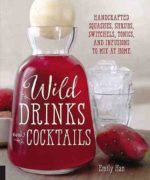Wild drinks and cocktails; Handcrafted Squashes, Shrubs, Switchels, Tonics and Infusions to Mix at Home. / Emily Han, 2016. Quarto Publishing Group, USA. 192 pages, color illustrations.

Containing all kinds of fruits, berries and herbs as additions to drinks for health and pleasure, Wild Drinks is a manual for handcrafted potables with the pizazz of nature’s flavors and the vitamin and mineral kick available from wildcrafting them. Both alcoholic and non, are offered in a near catalog of newly minted, old-favorite, even classic, recipes for your pleasure.
The mention of wildcrafting is interesting, if you find yourself near the source of wildly-growing (not cultivated) herbs and even fruits. However, it’s possible to get the idea of mixed potions with fruits you purchase at farmer’s markets or fruits and herbs you grow yourself.
Wild Drinks is a resource on the methods of culturing fermented beverages, bitters, flavored syrups and a variety of teas. Recipes are all involved with extracting taste from fruits or herbs, and sometimes even nuts! But it’s easy as the extraction methods vary from mixing and allowing to rest, allowing the ingredients to do their work within a culturing atmosphere—a closed container. For a few recipes, boiling and allowing to rest, created the necessary condition for extraction to take place, but nothing more complex (even for Rose Water), than that!
With these you can progress to mixed drinks with alcohol, or with juices, teas, your lemonade potions. Han shows you strikingly simple methods that appear to be no more complex than adding ingredients together, shaking, and then storing in order for flavors to merge with the medium.
Using Han’s add, shake or stir and store method you can make oxymels, switchels and shrubs, bitters, cocktails, sodas and fermented drinks. All of these integrate the chosen fruit or botanical flavor with a liquid—either vinegar, a spirit, or water (or tea)—and either sugar or honey.
How do you differentiate the tastes? Oxymels usually get their sublime and complex mouthfeel from combining vinegar and honey. Switchels, from the addition of shredded ginger to such a brew. Shrubs, on the other hand, are a strained concoction of vinegar and muddled-fruit, with sugar added after a resting period. Recipes once complete can be kept for a month or longer in the refrigerator.
Some recipes, like the one for Mint Sekanjubin call for honey and water to be combined in a saucepan to simmer with vinegar a few minutes, then mint leaves are added off heat and then cooled and strained. This is a basic recipe to which sliced cucumbers are added, and a cooling summer punch is ready for a crowd!
Syrups are more than simple affairs. Or they can be, with the range of Han’s recipes, a Pine, Date, Rosehip, Rhubarb and Rosehip, or Pomegranate syrup introduces you to a whole new world of tastes you prepare at home. Even Orgeat Syrup looks easy. Han’s is made with hazelnuts, with the mention that you can use the same method for pine nuts, walnuts, etc.
So, with syrups, wines and cocktails are easily managed. And they’re so versatile, they can be sprinkled over ice cream and salads, etc. at will.
What about fermented drinks like ginger bug (and ginger ale), blueberry soda, and water kefir-based drinks in a variety of flavors. These are just a few, and represent the complex methods found in Wild Drinks: you have to take care to ensure your containers are extremely clean, an additional ingredient is yeast, and sugar should be used rather than honey. But that’s it. What’s left to do is no more complicated than letting the mixture develop and watching for signs of fermentation that will naturally occur.
Recipes provide for one or two servings or up to four, rather than creating a surplus of liquid. This makes it easy to enjoy a variety of flavors, of course, but it’s also because the recipes contain close to a 1:1 ratio of fruit or botanicals to extractive liquid.
I think what I like best about Wild Drinks is that despite the simplicity of the recipes, Han provides background on each of them. Her collection is fascinating due to the cultural precedent that many represent: you can make your own Carmelite Water (a drink famous since 1600s and made by Carmelite monks as a health remedy, p. 126), Rose Water, a Middle-Eastern staple (along with Saffron for sweets), Berry Kompot, an Eastern European sweet drink, and Classic Switchel from the Caribbean. As well, varieties of syrups and cordials from Western and Chinese herbalism, France, England, Europe, and America, countries who’ve always loved developing the fruity flavor in hearty drinks and potions.
Visit Ms. Han’s website.
Follow



